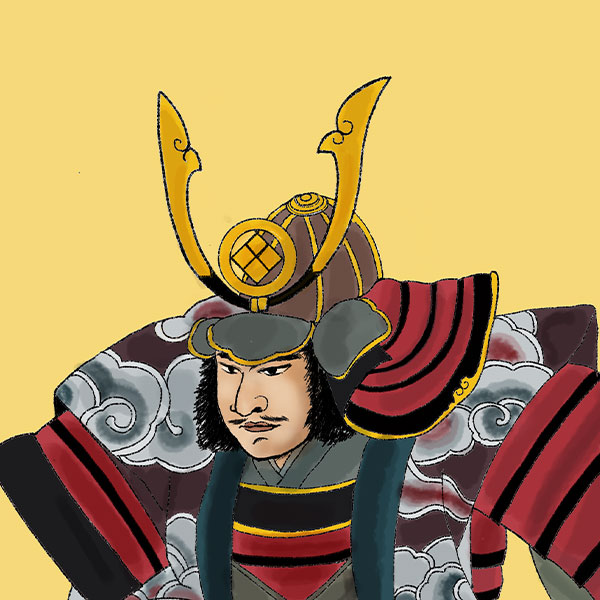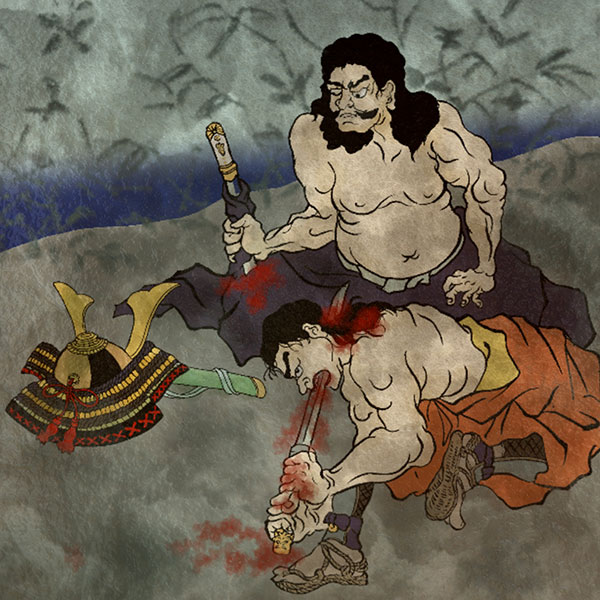Morinobu Nishina (2/2)Prince of the Takeda Clan who died for his brother

Morinobu Nishina
- Article category
- biography
- name
- Morinobu Nishina (1557-1582)
- place of birth
- Yamanashi Prefecture
- Related castles
- related incident
In the Edo period, it became the administrative center of the Takato Domain, and the castle was successively ruled by the Kyogoku, Hoshina, and Torii clans. In 1691, Naito Kiyohira was given a fief of 33,000 koku, and it became the castle of the eighth generation of the Naito clan until the start of the Meiji period.
Currently, the remains of the castle, such as stone walls, earthworks, dry moats, and gates, remain and the castle has been designated as a national historic site. In 2006, the castle was chosen as number 30 of Japan's 100 Greatest Castles. There are 1,500 Takatookohigan cherry trees planted here, making the castle a famous cherry blossom viewing spot.
Mount Goro and the statue of Morinobu Nishina
Nishina Morinobu committed suicide in 1582 during Oda Nobunaga's invasion of Kai.
After the battle, the neighboring farmers found the bodies of Morinobu Nishina and others at Takato Castle, cremated them at Wakamiyahara, and buried them on the mountain. Since then, the mountain has been called Goroyama (Morinobu Nishina's childhood name).
At the end of the Edo period, at the suggestion of Nakamura Mototsune, a doctor and Confucian scholar of the Takato Domain, shrines were built to worship the spirits of these people. Strictly speaking, the name of the mountains is Goroyama, and shrines were built to commemorate the spirits of the various warriors on Goroyama, the center, for Nishina Morinobu, on Shiroyama for his deputy commander Oyamada Bitchu, on Saburoyama for Watanabe Kintayu, the leader of the samurai group, on Jiroyama for Suwa Hana, who committed suicide after raiding the enemy ranks to avenge her husband (Suwa Yorikiyo), and on Ichiroyama for the various warriors.
To digress a little, Watanabe Kintayu has a shrine on Mt. Saburo. Kintayu had a unique career even in the Sengoku period. Watanabe Kintayu, more accurately Watanabe Kintayu-sho, is thought to have been one of the Watanabe Party, the many descendants of Watanabe Tsuna throughout Japan. He was originally a samurai from Totomi Province who served the Imagawa clan. However, after the fall of the Imagawa clan, he became one of the vassals who served the Tokugawa clan and defended Takatenjin Castle.
He also participated in the Battle of Anegawa in June 1570 on the side of Oda and Tokugawa, and in his striking attire of a vermilion spear and a gold strip of paper flag, he fought hard and was called "Japan's best spear master" by Oda Nobunaga, who counted him as one of the "Seven Spears of Anegawa". However, in 1574, when the Takeda clan took Takatenjin Castle, the Tokugawa retainers who had been holed up in the castle split into those who returned to Tokugawa territory and those who defected to the Takeda clan who had taken it. Watanabe Kintayu defected to the Takeda clan and participated in the Battle of Takato Castle. Then, in 1582, just before the Battle of Takato Castle began, the castle lord Nishina Morinobu tried to persuade Watanabe Kintayu, who was serving the Tokugawa clan, to defect to the castle and return to the Tokugawa. However, Watanabe Kintayu firmly refused, and shared the same fate as the castle. Watanabe Kintayu ran through the Sengoku period, serving different lords from the Imagawa clan to the Tokugawa clan to the Takeda clan. From this story, it is believed that a shrine was built and Watanabe Kintayu was enshrined.
When the NHK historical drama Takeda Shingen began airing in 1988, research into the Takeda clan became more active. At that time, an individual from Takato town, thinking of revitalizing Takato town and promoting tourism, built a statue of Nishina Morinobu on Mt. Goro and donated it to the town. The statue is based on a portrait of Nishina Morinobu that was owned by a person who is said to be a descendant of Nishina Morinobu, and is modeled after the figure of a warrior in battle, seated on a floor bench and wearing armor. People still visit Mt. Goro, where the spirits of Nishina Morinobu and the Takeda retainers who fought in fierce battles are enshrined.
Nagano Prefecture Song: Shinano no Kuni
Many prefectures across Japan have their own prefectural anthems (songs that are passed down and often referred to as the song of the prefecture's people), and Nagano Prefecture has an anthem called "Shinano no Kuni."
"Shinano no Kuni" was written in 1899 by Asai Sokaku of Nagano Normal School (currently the Faculty of Education at Shinshu University) for elementary school students, and composed by Kitamura Tokiharu for a female student athletic meet. Because the normal school where the song was written was a teacher training school, teachers who had studied at Nagano Normal School taught "Shinano no Kuni" at the schools where they were assigned, and it spread throughout the prefecture.
By the way, when the Meiji era began, Nagano Prefecture was divided into Nagano Prefecture in the north and Chikuma Prefecture in the south, with its prefectural office in Matsumoto. In the early Meiji era, these two prefectures were merged to form Nagano Prefecture, but the conflict that was even called the "Civil War" and the "North-South Gap" remained. In 1948, the Showa era began, and a proposal to divide the prefecture again, dividing it into north and south, was submitted to a regular Nagano Prefectural Assembly. At this time, it is said that the people of Nagano who were listening to the assembly sang "Shinano no Kuni" to show their opposition to the division plan, and the proposal was ultimately rejected. In 1968, Nagano Prefecture adopted "Shinano no Kuni" as its prefectural anthem.
Now, number 5 in "Shinano Province" lists great people who came from the prefecture. These include Shogun Minamoto no Yoshinaka from the Genpei period, the literary giant Dazai Osamu, Western scholar Sakuma Shozan from the end of the Edo period, and Nishina Morinobu, who fought bravely while holed up in Takato Castle. Thus, Nishina Morinobu has become a familiar figure in Nagano Prefecture even today.
The Shingen Festival and the Nishina Goromori Shinto Corps
In Yamanashi Prefecture, the "Shingen Festival" (held in the fall due to the COVID-19 pandemic) is held for three days from the Friday before April 12th (the anniversary of Takeda Shingen's death) every year. The highlight of the festival is the "Koshu Gundan Shutsushin," a period procession modeled after the 24 generals of the Takeda clan, and due to its large scale, it was recognized by the Guinness World Records in 2012 as the "festival with the largest number of samurai."
The origins of the "Shingen Festival" date back to the Cherry Blossom Festival that began in 1947. Since then, on the final day of the festival, a horseback procession has been held by local residents of the Aikawa district of Kofu City.
The first Kofu Shingen Festival was held in 1966, incorporating traditional festivals from around the country.
In 1969, influenced by the NHK historical drama "Heaven and Earth," the name was changed to "Shingen Festival" the following year, and it has remained that way ever since.
The climax of the current "Shingen Festival" is the warrior procession that often takes place. Volunteers are recruited from administrative organizations, supporting companies, and sister states and prefectures (such as Iowa in the United States) to participate as warriors in this warrior procession. They are divided into the "Wind Corps," "Forest Corps," "Fire Corps," "Mountain Corps," and "Main Corps/Takeda Era Corps" under the "Furinkazan" flag. Nishina Morinobu is part of the "Main Corps/Takeda Era Corps," showing off the bravery of the warriors of the past.
Reread the article on Morinobu Nishina
- related incident

- WriterTomoyo Hazuki(Writer)I have loved history and geography since my student days, and have enjoyed visiting historical sites, temples and shrines, and researching ancient documents. He is especially strong in medieval Japanese history and European history in world history, and has read a wide range of things, including primary sources and historical entertainment novels. There are so many favorite military commanders and castles that I can't name them, but I especially like Hisashi Matsunaga and Mitsuhide Akechi, and when it comes to castles, I like Hikone Castle and Fushimi Castle. Once you start talking about the lives of warlords and the history of castles, there's a side of you that can't stop talking about them.



